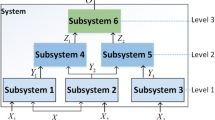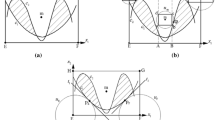Abstract
The current research of the decomposition methods of complex optimization model is mostly based on the principle of disciplines, problems or components. However, numerous coupling variables will appear among the sub-models decomposed, thereby make the efficiency of decomposed optimization low and the effect poor. Though some collaborative optimization methods are proposed to process the coupling variables, there lacks the original strategy planning to reduce the coupling degree among the decomposed sub-models when we start decomposing a complex optimization model. Therefore, this paper proposes a decomposition method based on the global sensitivity information. In this method, the complex optimization model is decomposed based on the principle of minimizing the sensitivity sum between the design functions and design variables among different sub-models. The design functions and design variables, which are sensitive to each other, will be assigned to the same sub-models as much as possible to reduce the impacts to other sub-models caused by the changing of coupling variables in one sub-model. Two different collaborative optimization models of a gear reducer are built up separately in the multidisciplinary design optimization software iSIGHT, the optimized results turned out that the decomposition method proposed in this paper has less analysis times and increases the computational efficiency by 29.6%. This new decomposition method is also successfully applied in the complex optimization problem of hydraulic excavator working devices, which shows the proposed research can reduce the mutual coupling degree between sub-models. This research proposes a decomposition method based on the global sensitivity information, which makes the linkages least among sub-models after decomposition, and provides reference for decomposing complex optimization models and has practical engineering significance.
Similar content being viewed by others
References
KROO I, ALTUS S, BRAUN R, et al. Multidisciplinary optimization methods for aircraft preliminary design[R]. Washington, D.C., USA: NASA Langley Technical Report Server, 1994: 697–707.
MA Mingxu, WANG Chengen, ZHANG Jiayi, et al. Multidisciplinary design optimization for complex product review[J]. Chinese Journal of Mechanical Engineering, 2008, 44(6): 16–20. (in Chinese)
NATALIA M, ALEXANDROV N M, HUSSAINI M Y. Multidisciplinary design optimization: state of the art[M]. Hampton, Virginia, ICASE/NASA Langley workshop on MDO, 1995: 90–97.
KODIYALAM S, SOBIESKI J S. Multidisciplinary design optimization-some formal methods, framework, requirements, and application to vehicle design[J]. International Journal of Vehicle Design, 2001, 25(1): 3–22.
SOBIESKI J S. Multidisciplinary aerospace design optimization: survey of recent developments[J]. Structural Optimization, 1997, 14(1): 1–23.
KIM H M, KOKKOLARAS M, LOUCA L S, et al. Target cascading in vehicle redesign: A class VI truck study[J]. International Journal of Vehicle Design, 2002, 29(3): 199–225.
SOBIESKI J S, JAROSLAW T. MDO can help resolve the designer’s dilemma[J]. Aerospace America, 1991, 29(9): 32–35.
TAPPETA R V, RENAUD J E. Multi-objective collaborative optimization[J]. Journal of Mechanical Design, 1997, 119(3): 403–410.
WUJEK B A, RENAUD J E, BATILL S M. Concurrent subspace optimization using design variable sharing in a distributed computing environment[J]. Concurrent Engineering: Research and Application, 1996, 4(4): 361–275.
BRAUN R D, KROO I M. Development and application of the Collaborative optimization architecture in a multidisciplinary design environment[R]. Philadelphia, NASA Langley Technical Report Server, 1997: 98–116.
BRAUN R D, KROO I. Use of the collaborative optimization architecture for launch vehicle design[C]//6th AIAA/USAF/NASA/ ISSMO Symposium on Multidisciplinary Analysis and Optimization, Washington, Sept. 4–6, 1996: 306–318.
KROO I, MANNING V. Collaborative optimization: Status and directions[C]//8th AIAA/NASA/ISSMO Symposium on Multidisciplinary Analysis and Optimization, Long Beach CA, Sept. 6–8, 2000: 2000–2017.
SOBIESKI J S, AGTE J S, SANDUSKY R R. Bi-level integrated system synthesis (BLISS)[R]. Hampton, Virginia, NASA Langley Research Center, 1998.
ZHANG **g, LI Bailin, LIU Yongjun. Decoupling method of multidisciplinary design optimization based on sensitivity analysis[J]. Journal of Southwest JiaoTong University, 2007, 42(5): 563–567. (in Chinese)
TONG Lingsheng, SHI Boqiang, SHEN Yanhua, et al. First-order reliability method based multidisciplinary design optimization on gear transmission[J]. Chinese Journal of Mechanical Engineering, 2010, 46(3): 42–46. (in Chinese)
MICHELENA N, KIM H M, PAPALAMBROS P. A system partitioning and optimization approach to target cascading[J]. International Conference on Engineering Design, 1999, 26(24): 1109–1112.
MICHELENA N, Park H, PAPALAMBROS P. Convergence properties of analytical target cascading[J]. American Institute of Aeronautics and Astronautics Journal, 2003, 41(5): 897–905.
LIU Huibin, CHEN Wei. Probabilistic analytical target cascading: A moment matching formulation for multilevel optimization under uncertainty[J]. Journal of Mechanical Design, 2006, 128(6): 991–1011.
LI Yan**g, LU Zhaosong, MICHALEK J J. Diagonal quadratic approximation for parallelization of analytical target cascading[J]. Journal of Mechanical Design, 2008, 130(5): 51402–05140210.
CHU Xuezheng. Research on design space exploration and coordinated decomposition methods for complex product[D]. Wuhan: Huazhong University of Science and Technology, 2010. (in Chinese)
SOBOL’ I M. Global sensitivity indices for nonlinear mathematical models and their Monte Carlo estimates[J]. Mathematics and Computers in Simulation, 2001, 55(3): 271–280.
TOSHIMITSU H, SALTELLI A. Importance measure in global sensitivity analysis of nonlinear models[J]. Reliability Engineering and System Safety, 1996, 52(1): 1–17.
DENG Zhaoxiang, YAN Changzheng. Sensitivity analysis of a motorcycle frame using the Monte Carlo method[J]. Journal of Chongqing University, 2008, 31(10): 1113–1122. (in Chinese)
KODIYALAM S. Evaluation of methods for multidisciplinary design optimization (MDO) Phase 1[R]. Washington: National Aeronautics and Space Administration, 1998: 23–26.
XUE Caijun, NIE Hong, QIU Qingying, et al. A peer-to-peer distributed collaborative optimization system[J]. Scientific Programming, 2004, 12(2): 121–131.
Author information
Authors and Affiliations
Corresponding author
Additional information
Supported by National Natural Science Foundation of China (Grant No. 51075356), and National Key Technology R&D Program (Grant No. 2013BAF07B04)
QIU Qingying, born in 1970, is currently an associate professor at Zhejiang University, China. His research interests include innovative design and optimization design.
LI Bing, born in 1984, is currently a PhD candidate at Zhejiang University, China. His research interests include multidisciplinary design optimization.
FENG Peien, born in 1943, is currently a professor and a PhD candidate supervisor at Zhejiang University, China. His research interests include mechanical design theory and methodology.
GAO Yu, born in 1973, is currently a lab technician at Zhejiang University, China. His research interests include construction machinery intelligent control and energy-saving.
Rights and permissions
About this article
Cite this article
Qiu, Q., Li, B., Feng, P. et al. Decomposition method of complex optimization model based on global sensitivity analysis. Chin. J. Mech. Eng. 27, 722–729 (2014). https://doi.org/10.3901/CJME.2014.0516.096
Received:
Revised:
Accepted:
Published:
Issue Date:
DOI: https://doi.org/10.3901/CJME.2014.0516.096




